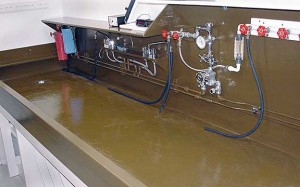JB & Susan Harlin
www.jbhphoto.com
Susan Has New Photos
 Susan has been faithfully printing new negatives for the last three months. She has several new photos from our last trip to Southern Utah now added to her web gallery.
Susan has been faithfully printing new negatives for the last three months. She has several new photos from our last trip to Southern Utah now added to her web gallery.
There are also new images from older negatives, both 4×10 and 8×20 that did not work out well on some of the paper we had on hand at the time. Using some vintage Kodak Azo paper and a modified developer formula, she was able to make some brilliant prints from these older photographs from earlier trips. To view Susan’s photo gallery click HERE.
Thanks for looking,
JB & Susan
Dry Mounting Photographs
To dry mount or not. . . that is a question? This debate seems to roll on forever. Sort of like Ford or Chevy? Is there really a correct answer? I have made my choice.
For me there is nothing that comes close to a properly dry mounted photograph. Once I made my choice, all I had to do was learn the process. I worked out a method that gives me what I like, and if you are interested in dry mounting your photos and have never learned the process, I have a little booklet that details my procedure.
This is not the only way, it is just my way. . . and. . . if you are interested, it is FREE!!! Take a look HERE for “DRY MOUNTING PHOTOGRAPHS” pdf download.
UTAH DECEMBER 2008
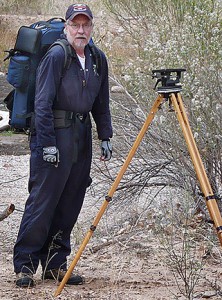 In a previous post I talked about issues that seem to crop up when shooting sheet film. When I refer to issues, I am talking about things you can do unintentionally that may or may not ruin a particular negative. See my previous post “WHAT CAN GO WRONG?” for a better idea of the issues.
In a previous post I talked about issues that seem to crop up when shooting sheet film. When I refer to issues, I am talking about things you can do unintentionally that may or may not ruin a particular negative. See my previous post “WHAT CAN GO WRONG?” for a better idea of the issues.
We spent the entire month of December 2008 in Utah. This was one of our typical photo trips and we were there to make photographs. This trip we brought back 276 sheets of film in four formats ranging from 4×10 to 11×14.
Mistakes? Who makes mistakes? Issues? What Issues? Of the film that I exposed, I had 136 sheets in two sizes. Of those sheets, there were three sheets that I ruined, due to just plain dumb mistakes.
At lot of my mistakes come near the end of the day, when I am tired. Lugging 40-50 pounds all day in the snow will wear you down. I do make mistakes. No matter how hard I try, I seem to always screw up a few sheets of film. The biggest one this trip you ask? I double exposed an absolutely great photo of glowing cottonwood trees. I now have this strange 8×10 negative with two large trees. . . at right angles! Yes, the first exposure was a horizontal, the second was vertical. Oh well. I did make several other negatives of the same tree, so not all is lost. And as I said in my previous post, I had a few choice words!
JB
THE SINK FINISH
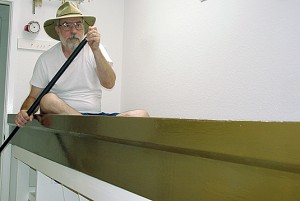 Once you become a serious darkroom worker you will eventually want a real darkroom sink with running water. The question is, to buy, or to build? Certainly, if you have deep pockets, you can buy a commercial stainless steel sink. You can even have a stainless sink custom fabricated. Just be forewarned, you are looking at a serious amount of money.
Once you become a serious darkroom worker you will eventually want a real darkroom sink with running water. The question is, to buy, or to build? Certainly, if you have deep pockets, you can buy a commercial stainless steel sink. You can even have a stainless sink custom fabricated. Just be forewarned, you are looking at a serious amount of money.
What most do is build their own sink, typically from wood. This is my favorite construction technique and allows me to build a very functional sink to any size required. In the previous post titled “NOT THE KITCHEN SINK” we showed what it took to build a large darkroom sink from wood. Robust construction is essential to make sure the sink does not flex. Flexing can cause the finish to crack and begin to leak.
My philosophy of sink building is to build the thing like a boat. Using construction robust enough to sail the ocean. That way it is strong enough to stand up to most anything. Once complete, I like to climb into the sink and jump up and down. If nothing moves, creaks, or breaks, I am satisfied that I have a good strong sink.
Waterproofing is the next order of business. Caulking all seams is a must to insure no leaks. Next comes some form of durable, waterproof coating. I built one sink years ago and used fiberglass. Never again! Way too messy for me, and I hate working with the stuff.
After much research I found a suitable coating for my darkroom sink. Tile-Clad® HS Epoxy is a two-part, commercial-grade, epoxy-polyamide coating from Sherwin-Williams. This epoxy paint is used in power plants, offshore structures, schools, storage tanks, laboratories, hospitals and marine applications. This stuff dries rock hard and is near impervious to most chemicals.
I have found that two generous coats of Tile-Clad® makes a great smooth waterproof finish for a darkroom sink. You can also have the paint tinted to most any color you desire. Most any Sherwin-Williams store should have Tile-Clad® and be able to tint it for you. Be prepared, this material is not cheap. Seven years ago when we built our last sink it was about $110.00 for a gallon of part ‘A’ and part ‘B’ which, when mixed, makes two gallons of paint.
The main points to keep in mind when building a darkroom sink is make it robust in construction, waterproof, and resistant to chemicals. Whatever finish you choose, whether it be fiberglass or Tile-Clad®, if the sink flexes, the finish will crack. Build your sink like your life depends on its integrity and you will never have leaks nor have to build another. . . unless. . . you decide you need a larger one!
For those interested in why we chose this chocolate brown color, the first sink I built was white. Amidol and Pyro left stain spots all over the sink. We chose the closest color to the stains from the color swatches from Sherwin-Williams and had the paint tinted that color. Developer stains do not show!
JB
ILFORD ULF FILM 2009
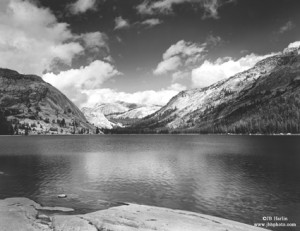 For the second consecutive year, one of the Harlin photographs has been chosen, along with a quote from the artist, to be included in the annual Ilford ULF film order press release. This year JB’s image titled “Tenaya Lake, 2007” will appear in the annual announcement and call for orders of special size film. Details can be found on the Ilford web site;
For the second consecutive year, one of the Harlin photographs has been chosen, along with a quote from the artist, to be included in the annual Ilford ULF film order press release. This year JB’s image titled “Tenaya Lake, 2007” will appear in the annual announcement and call for orders of special size film. Details can be found on the Ilford web site;
http://ilfordphoto.com/pressroom/latest.asp
We are again excited to be included in this year’s Ilford ULF film buy. A PDF, containing a larger version of the photograph, along with this year’s original release is available HERE.
Susan’s image from last year’s press release titled “Alabama Hills, Mt. Whitney” was also featured on display at the Ilford/Harmon booth at the 2008 PDN PHOTO PLUS International Conference and Expo in New York City. Last year’s press release can be found HERE as a PDF also.
YOUR DARKROOM
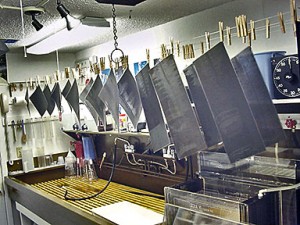 Everyone that has dabbled with their own film and print processing has been forced to build some sort of minimal darkroom. It is amazing to hear all of the darkroom stories from those that have been there and done that. But the truth is, there are many serious photographers, that have created amazing bodies of work with only the most basic darkrooms.
Everyone that has dabbled with their own film and print processing has been forced to build some sort of minimal darkroom. It is amazing to hear all of the darkroom stories from those that have been there and done that. But the truth is, there are many serious photographers, that have created amazing bodies of work with only the most basic darkrooms.
My first darkroom was in a small closet in a small apartment. I bought a garment rack and my clothes hung behind the bedroom door. A working darkroom does not have to look good. . . it just has to work good. You can load film, expose, and process paper in most any area that can be made lightproof. Once loaded into the tank, film can be processed on the bathroom vanity or kitchen counter. Paper, once processed, can be washed wherever you can set up a washer.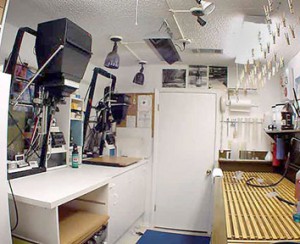
When you start out you may move. No telling how many times you may move before you finally settle in one place. An elaborate and expensive darkroom is nice, but if you relocate, you leave most of it behind. If you rent you have to be creative. I have moved numerous times and the more you move, the better you get at setting up some area as a darkroom.
You don’t need running water, it is nice, but not necessary. You can wash prints in the spare bathroom shower, or tub. One time I had a dry sink made from an old door, with sides screwed to it and painted with enamel paint. I later modified this with a drain, but it ran into a five gallon bucket. This was set up in a spare bedroom, with black plastic over the window. I washed prints in a print washer on the floor of the shower.
You can improvise as required when it comes to the setup. Buy a really good enlarger, with a good lens. The rest is up to you and your budget. A few trays, storage bottles, daylight film tank and chemicals and you are ready to get started. The fact is, you do not need an expensive, nor elaborate, darkroom to make seriously significant prints. Learn to make the most of what is available and put your money and effort into making fine prints. Don’t let the lack of a fully equipped darkroom come between you and your creativity. You can build that dream darkroom later.
JB
NOT THE KITCHEN SINK
In the fall of 2002 we made the reluctant decision that we needed a larger darkroom sink. This sparked a month long project of designing a new 3 1/2×10 1/2 foot sink. The new, larger, sink was to be modeled after the current, smaller, sink. The same basic idea was to be employed. The sink height would be the same. The depth would be greater and it would be as long as the room would allow, about 10.5 feet.
Cabinets for storage would be constructed at each end of the sink with slots for trays in between. There would be space in the right hand end for the water chiller and racks for chemical storage at each end. The backsplash would be a copy of the old one, only larger, and would contain the same plumbing, including filters, two mixing faucets and temperature control unit.
Having determined the necessary measurements it was just a matter of gathering the materials and getting to work. It took about three weeks to complete and install the new sink. Construction was my usual battle ship, massive over kill, design, using plenty of nails, screws, lag bolts, caulk and paint.
For those that are interested in seeing what is involved in building a wooden sink, click HERE to visit our snapshot album chronicling that little undertaking. This is not your typical kitchen sink!
COLD LIGHT?
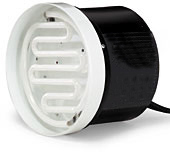 Ever wonder exactly how a Cold Light enlarger head works? How can light be Cold? The grid lamp-type enlarger light source definitely generates much less heat when compared to an incandescent light source. The heat of an incandescent lamp is generated by the infrared radiation produced by the heated filament in the lamp. A typical incandescent lamp produces more IR than visible light. In the simplest terms, the Cold Light does not generate that much IR, hence less heat. But what exactly is a Cold Light?
Ever wonder exactly how a Cold Light enlarger head works? How can light be Cold? The grid lamp-type enlarger light source definitely generates much less heat when compared to an incandescent light source. The heat of an incandescent lamp is generated by the infrared radiation produced by the heated filament in the lamp. A typical incandescent lamp produces more IR than visible light. In the simplest terms, the Cold Light does not generate that much IR, hence less heat. But what exactly is a Cold Light?
Most Cold Light enlarging heads contain what is known as cold cathode lighting. And, yes there is also what is known as hot cathode lighting. You say you have never heard of such things? Maybe not, but you see them both most every day. Cold cathode lighting is simply neon. That neon OPEN sign at the convenience store is a cold cathode light. The fluorescent light in your hallway is hot cathode lighting. In simplest of forms, they are both gas discharge lamps.
There are a few of the larger Cold Light enlarger heads that use fluorescent lamps, but most Cold Light heads contain cold cathode grid lamps. Without getting into a technical discussion, the usual Cold Light head is nothing but a neon sign. The glass lamp is bent into a grid instead of spelling out some advertising slogan or the word OPEN.
A cold cathode lamp depends on high voltage to operate. Your small Cold Light head will use a voltage around 6KV (6,000) volts. A larger head can use up to 12KV to operate. The high voltage source is current limited in order to keep the lamp from overheating. By adding different rare gasses and phosphor coatings inside the lamp it is possible to create different colors of light.
The dual grid Variable Contrast Cold Light (VCCL) heads, used with variable contrast papers, have two grids. One green grid for printing soft contrast and a blue grid for printing hard contrast. Adjusting the intensity of each lamp, by varying the voltage, allows you to mix different amounts of each light to achieved a continuously variable contrast grade on VC paper.
So, now you know! That Cold Light enlarger head is nothing more than a specially designed neon sign. And, one important thing to remember and this is important! There is very high voltage inside that Cold Light, so unless you know what you are doing, Keep Out!!!
JB
IS THAT AN OLD CAMERA?
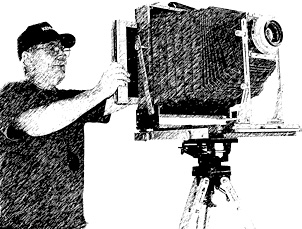 How many times have I been asked, “is that an old camera?” I usually have to explain that no, it is actually a modern version of an old camera. Seldom am I asked why I would use something like an old bellows-type camera. But I get the feeling that there are those that would like to ask why.
How many times have I been asked, “is that an old camera?” I usually have to explain that no, it is actually a modern version of an old camera. Seldom am I asked why I would use something like an old bellows-type camera. But I get the feeling that there are those that would like to ask why.
Am I the only one that believes that simplicity has its place? For me, it really has its place when it comes to my art form. When I get out in the field, I want the equipment to become transparent in its function. And, the best way I have found to achieve this transparency is through simplicity.
I have started a list of things that I like about using a view camera. It goes something like this:




